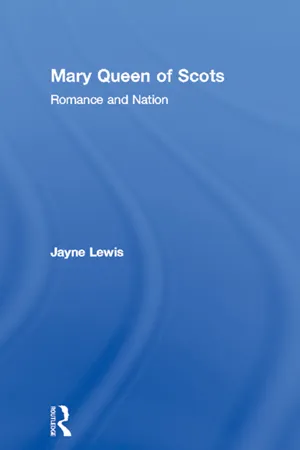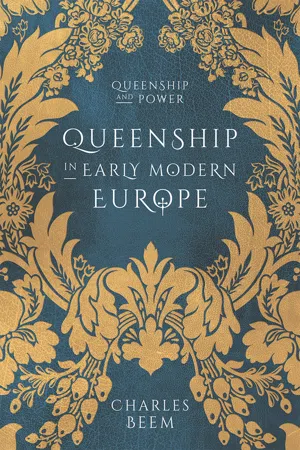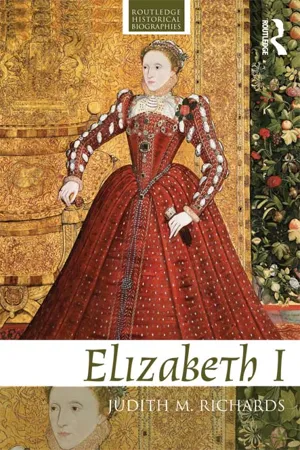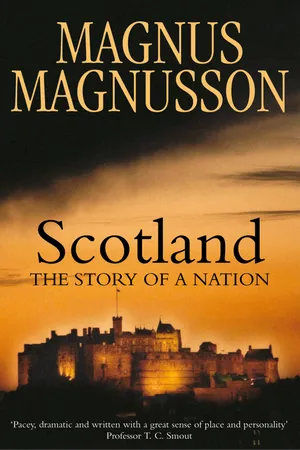History
Mary, Queen of Scots
Mary, Queen of Scots, was a significant figure in the 16th century, known for her tumultuous reign and eventual execution. As the Catholic heir to the Scottish and English thrones, her life was marked by political intrigue, religious conflict, and her rivalry with Queen Elizabeth I of England. Her complex legacy continues to captivate historians and the public to this day.
Written by Perlego with AI-assistance
Related key terms
4 Key excerpts on "Mary, Queen of Scots"
- eBook - ePub
Mary Queen of Scots
Romance and Nation
- Jayne Lewis(Author)
- 2005(Publication Date)
- Routledge(Publisher)
But when it came to the Queen of Scots it clearly did not take a German pen to blend pathos with baroque sexuality, confessions of guilt with the possibility of a higher purity. On the contrary, the need to reconcile a Mary flagrantly guilty of experiencing and arousing passion with a too harshly punished one was finally British in the extreme. Its inherent contradictions provided a Regency-era analogue to Elizabethan conflicts and Stuart ambivalences alike, even as the delicate myths of high sentimental culture were exposed to present-day anxieties about foreign invasion and exorbitant female desire. The Queen of Scots had, of course, always stood for certain recurrent threats to Britain’s evolving political and psychological coherence—for absolute female authority, Roman Catholicism, and France. Now those threats had to be domesticated if what they threatened was to prevail. Just so, when we listen to what nineteenthcentury Britons had to say about Mary, it seems that taming the specter of her longings was often a means of engaging the feminine jele veux itself, or at least of making contemporary projections and phantasms of female desire somehow palatable. And, as we might expect, contemporary encounters with Mary usually reflected the degree of similarity between their author and the Queen of Scots. So, for example, many women leapt to Mary’s defense, ironically aware that their faith in her was groundless but nonetheless conscious of its potential not only to validate their own inadmissible wishes but also to unite them with other women in a like state of economic or political deprivation. On the other hand, male protagonists often faced destruction at the hands of their own infatuation with an enticing but incalculable Queen of Scots. For men and women alike, though, to vindicate Mary was in the end to vindicate their own desires for recognition and symbolic power - eBook - ePub
- Charles Beem(Author)
- 2019(Publication Date)
- Bloomsbury Academic(Publisher)
By 1554, Mary assumed the regency of Scotland. With vigor and determination, Mary imposed a king-like authority upon her daughter’s kingdom, enforcing the laws, going on progress, and financing her government through the profits of her industrial enterprises. At the same time, Mary governed, as her Guise relatives had advised, with “conciliation, gentleness, and moderation,” much in the manner of her neighbor, Mary I of England, who, as we have seen, also brought a queenly approach to her female kingship. But despite Mary’s political skill and acumen, the outbreak of the Scottish Reformation, a more grassroots movement than that which emerged in England, stymied her ability to create political consensus. While the first three years of Mary’s formal regency witnessed a stabilization of royal control, the events of 1558–1560 spiraled out of control, necessitating her continued presence in Scotland, at the expense of missing her daughter’s wedding to the dauphin in France. Even before this, in 1557, Mary induced the Scottish parliament to enter the Habsburg-Valois war of 1557, in which England had entered on the side of Spain, resulting in a series of border skirmishes. But it was a pyrrhic victory; Mary I of England died in November 1558 and was succeeded by her half-sister Elizabeth, whom the Lords of the Congregation swiftly viewed as their natural ally.Mary was initially successful in military operations against the Protestants as English troops were repulsed, but the promised French convoy from Calais never arrived after an English fleet showed up in the straits of Fife. Mary’s health slowly deteriorated, with the kind of swelling in her legs and resulting lameness that her daughter would also suffer from. In the spring of 1560, Mary met with the Lords of the Congregation, desirous of peace, and begged them to maintain the French alliance as well as her daughter’s queenship. She died in June, fearful for the future of her daughter’s crown in a Protestant Scotland.Within the larger context of Early Modern European queenship, Mary of Guise set a standard for queenly achievement. She had married James V swiftly after the death of her first husband, leaving her young son in France to become Scotland’s queen, quickly bearing a series of children for her husband before his untimely demise, four years into her queenship. As a still youthful and eligible widow, Mary put her daughter’s interests before her own, remaining unmarried and in Scotland, securing a future king for her daughter while negotiating as best she could the dynamic vagaries of the Scottish Reformation with skill, confidence, and determination. Mary of Guise’s dowager queenship was a powerful model for Catherine de Medici, who in 1560 began her own tumultuous career as both regent and powerful player in French politics. - eBook - ePub
- Judith M. Richards(Author)
- 2013(Publication Date)
- Routledge(Publisher)
2 On the other hand, it might be noted that she had come to the throne at a time when religious divisions between Catholic and Protestant believers were increasingly a major factor in wars, both civil and international, across Europe; to most modern eyes, one of the more remarkable achievements of her regime was that the same pattern was not established in her England despite recurrent threats, and a major factor in this relative peace was precisely the degree of accommodation that she offered. It must, however, be noted that probably few devout contemporaries shared that modern admiration for her moderate stance.The fall and flight of Mary Queen of Scots
Meanwhile, back in Scotland, although after the christening of their son relations between Mary and her husband seemed to have improved, this soon proved to be illusory. There followed a sequence of extraordinary events, beginning with the violent death of Darnley; about the responsibility for that historians still argue, and disagree on where culpability for the several crimes within the royal circle lay.In outline, relations worsened again between the Scottish queen and her husband – a man, it might be noted, universally agreed to be of deplorable character (excepting only, perhaps, by his immediate family). Darnley, who had been ill, was apparently reconciled with his wife, but murdered in her absence, and almost immediately the queen married Bothwell, the man most widely believed to have been responsible for her husband's death. The marriage had been preceded by Bothwell's sudden divorce of his wife, and perhaps by Bothwell's rape of the widowed queen. Many have doubted the rape, but Robert Melville, who was once again near the heart of events, always thought it had indeed occurred. Whatever the reason for the marriage having taken place, it also set off a series of battles within Mary's realm that culminated in the defeat of Mary and Bothwell, with the latter soon fleeing Scotland and Mary being taken prisoner and placed in a castle in the middle of Loch Leven. It was from such events that two feuding groups emerged: the queen's men (for Mary) and the king's men (soon promoting the abdication of Mary and the installation of her infant son as nominal king, with Mary's illegitimate half-brother, the Earl of Moray, as regent).For the purposes of this study, the significance of those events lies primarily in the response of Elizabeth to them, above all to the imprisonment of another monarch. In general, the English councillors were delighted at Mary's disgrace, particularly by her quick remarriage to the likely murderer of her previous husband. Those who shared Cecil's views that her claim to be Elizabeth's heir apparent made Mary a potent threat to English security were particularly pleased at what was seen as her destruction of her own reputation. As one English observer contentedly remarked, Mary's fall was another example of the inevitable fate of ‘such as live not in the fear of God’. - eBook - ePub
Scotland
The Story of a Nation
- Magnus Magnusson(Author)
- 2016(Publication Date)
- HarperCollins(Publisher)
When Mary had left for France in the summer of 1548 the south of Scotland was under English military occupation as a result of the ‘Rough Wooing’; but as part of her marriage treaty, French troops had arrived to give much-needed support to Scotland’s hard-pressed war effort. Within a year the position had been totally changed: the English had abandoned the ‘Rough Wooing’ and withdrawn their occupation forces, but the French army had remained to support the pro-French Catholic party which now held power. The Earl of Arran’s half-brother, John Hamilton, who had been appointed Archbishop of St Andrews in succession to the murdered Cardinal Beaton, was more prepared to make compromises with the reformers than his predecessor had been; he went some way towards satisfying the demands for Church reform without altering its ecclesiastical structure. Three councils of the Scottish Church passed legislation to curb abuses in the Church system; a new Catechism made some concessions to the Lutheran teaching of ‘justification by faith alone’; and endowments were made for the better education of priests. It was a start – but in the event it was too little and too late.The queen mother, Marie de Guise, had been working hard in the background to look after her daughter’s realm.1 She was a handsome, charming woman ‘of majestic stature’ who spoke broken English with an attractive French accent. Throughout her daughter’s early years she had steered a careful political course with great courage and skill. Now, as the 1550s dawned and the English occupation ended, she came into her own. In 1550 she took to France a distinguished company of Scottish notables in order to dazzle the waverers with a sight of the successes and brilliant cultural achievements of Renaissance France. The mission had the desired effect. When Mary Queen of Scots legally came of age in France in 1554 she was entitled to choose her regent in Scotland; not surprisingly, she chose her mother, and the Duke of Châtelherault (Arran) was cajoled and bribed into resigning.As queen regent, Marie de Guise had already gained widespread respect and acceptance among the Scottish political community. In religion she was neither a zealot nor a persecutor, and she now did everything she could to conciliate the conflicting interests of the people of Scotland. Pastors of the Lutheran persuasion were allowed to preach without hindrance and, during the ferocious Counter-Reformation years of rule by Mary Tudor (‘Bloody Mary’, r.1553–58) in England, the queen regent allowed English Protestant refugees to find sanctuary in Scotland.1
Learn about this page
Index pages curate the most relevant extracts from our library of academic textbooks. They’ve been created using an in-house natural language model (NLM), each adding context and meaning to key research topics.



